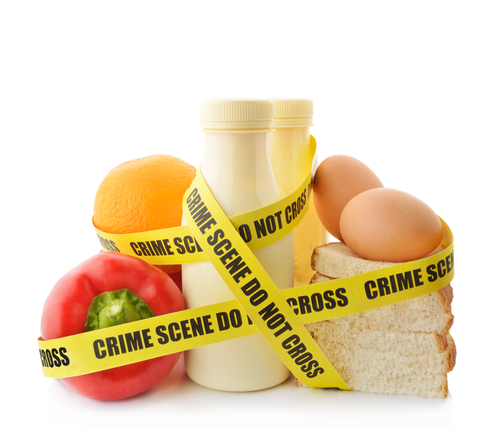How Mail-Order Food Retailers Guarantee Freshness
By Joan Miloscia | Posted on November 22, 2019

Food Supply Chain: The Challenge to Keep Food Fresh
 Specialty food producers and distributors often do business with razor-thin margins in a complex food supply chain. And, with so many online products and services at our fingertips, consumers are accustomed to the ease and efficiency of purchasing a specialty food product, such as their favorite mustard or jam, online. While consumers of the past may not have thought a lot about the complex supply chain their product travels through before it arrives at their door, this is rapidly changing. With concepts such as “farm to fork” becoming more prevalent, many customers are demanding full transparency before buying a food product, so they know exactly how their food was produced. And, as the supply chain becomes more complex, with many parties involved in getting the specialty food product to the customer, problems may arise.
Specialty food producers and distributors often do business with razor-thin margins in a complex food supply chain. And, with so many online products and services at our fingertips, consumers are accustomed to the ease and efficiency of purchasing a specialty food product, such as their favorite mustard or jam, online. While consumers of the past may not have thought a lot about the complex supply chain their product travels through before it arrives at their door, this is rapidly changing. With concepts such as “farm to fork” becoming more prevalent, many customers are demanding full transparency before buying a food product, so they know exactly how their food was produced. And, as the supply chain becomes more complex, with many parties involved in getting the specialty food product to the customer, problems may arise.
A standard food supply chain consists of production, processing, distribution, retailing and consumption. Breakdowns in any step of the process can create problems in guaranteeing freshness to the consumer. Extremely perishable food such as meat and fresh vegetables are especially prone to spoilage due to improper transport temperature and transport time. With the rise in popularity of meal kits that offer fresh food (such as Blue Apron and Hello Fresh) delivered to your door means that guaranteeing food freshness on a specified delivery date presents a greater challenge in the process. According to Statista, the food delivery market is projected to grow by 9.9% by the year 2023. The industry is burgeoning and maintaining fresh food is paramount to its success. Food transporters are on tight shipping deadlines and improper handling of food in this part of the chain—such as inadequate cooling or too much moisture in container—can result in spoilage, waste, and illness. With evolving consumer purchasing patterns and selling food products on a global scale, the food supply chain is beginning to evolve in order to meet the new demands. That evolution is pointing toward technology and the use of serialization in the food supply chain.
https://www.statista.com/outlook/374/100/online-food-delivery/worldwide
Food Serialization: Lessons from the Pharmaceutical Industry
Serialization is the use of a unique identifier on a product to ensure traceability. If you are familiar with the term ‘serialization’, it may be in connection with the pharmaceutical industry. Counterfeit and falsified drugs present a major public health risk.  These drugs are may have components from different countries of unknown origin. These illegal, counterfeit drugs can cause adverse reactions including death. Without an effective supply chain in place it’s difficult, if not impossible, to determine their origin. In an effort to combat these unsafe substances from harming the general public, the U.S. Drug Quality and Security Act was established and signed into law by Congress in November 2013. The act outlines steps to identify and trace prescription drugs as they are being distributed in the U.S. In addition to a means for identifying fraudulent drugs, the act also requires wholesale distributors and third-party logistics providers to obtain licensing and provide this information annually to the Federal Drug Administration. While serialization is not yet legally required for food products, there are some very good reasons for those involved in the food manufacturing or distribution chain to consider serializing.
These drugs are may have components from different countries of unknown origin. These illegal, counterfeit drugs can cause adverse reactions including death. Without an effective supply chain in place it’s difficult, if not impossible, to determine their origin. In an effort to combat these unsafe substances from harming the general public, the U.S. Drug Quality and Security Act was established and signed into law by Congress in November 2013. The act outlines steps to identify and trace prescription drugs as they are being distributed in the U.S. In addition to a means for identifying fraudulent drugs, the act also requires wholesale distributors and third-party logistics providers to obtain licensing and provide this information annually to the Federal Drug Administration. While serialization is not yet legally required for food products, there are some very good reasons for those involved in the food manufacturing or distribution chain to consider serializing.
(source //www.fda.gov/drugs/drug-supply-chain-integrity/drug-supply-chain-security-act-dscsa)
Food Safety and Recalls

Producing or distributing a food product includes the inherent risk that something has gone wrong in the process and tainted food or an unsafe product is on the shelves for the public to consume. The risks to safety in counterfeit food products present as big of a risk as that of pharmaceuticals. Recalls of food products do happen and they can be disastrous. Headlines on any given day may include a major recall of a food product. In 2018, the FDA completed an investigation into a multi-state outbreak of E.Coli O157:H7 which was linked to romaine lettuce grown in California. In total, there were over 62 cases of illness in 16 states and the District of Columbia. The FDA in conjunction with the CDC determined that 30 of 36 customers indicated they had eaten romaine lettuce the week before they became ill. The FDA issued a public health advisory based upon their investigation on November 20, 2018. Because the growing locations and dates of harvest were unclear, the FDA recommended no romaine lettuce be consumed. It wasn’t until December 13, 2018 that the investigation narrowed down the region to three California counties. Another major food recall occurred in 2008 by the Peanut Corporation. A strain of salmonella was found in its products and that resulted in the deaths of 8 people and sickened over 600 in the U.S. and Canada. In this instance, the Peanut Corporation recalled over 3,200 different products. The company ultimately filed a Chapter 7 bankruptcy in 2009. Tainted food products present a massive risk to manufacturers and distributors for consumer illness and potential death.
Food Product Traceability – A Solution
In a traditional food supply chain, breakdowns can be difficult to assess and that can cause inefficiencies, lost revenue and the  risk of major food recalls. Track & Trace solutions for food products can identify problems in real-time, pinpointing the source and problem in the supply chain all the way down to the specific container if warranted. Serialization provides inventory statistics in real-time so that businesses can meet consumer demand more efficiently. Data can be collected at any stage of the production cycle and all stakeholders can have real-time access to this information. Sources of ingredients can be tracked and monitored. Tracing identifies where products have been supplied and tracing may be linked to process improvements such as decreased error rates and streamlined document management. As every step in the chain is tracked, food waste can be managed more efficiently and ideally, reduced or eliminated. And, insurance companies may consider a tracking system in their evaluation of risk and potential reduction in exposure to lawsuits.
risk of major food recalls. Track & Trace solutions for food products can identify problems in real-time, pinpointing the source and problem in the supply chain all the way down to the specific container if warranted. Serialization provides inventory statistics in real-time so that businesses can meet consumer demand more efficiently. Data can be collected at any stage of the production cycle and all stakeholders can have real-time access to this information. Sources of ingredients can be tracked and monitored. Tracing identifies where products have been supplied and tracing may be linked to process improvements such as decreased error rates and streamlined document management. As every step in the chain is tracked, food waste can be managed more efficiently and ideally, reduced or eliminated. And, insurance companies may consider a tracking system in their evaluation of risk and potential reduction in exposure to lawsuits.
Brand Trust – Serialization to Create Loyal Customers
 Today customers have never been savvier in their desire for transparency with products that they purchase. Consumers are now considering the supply chain process in determining what products they buy. Customers are reading packaging and paying attention to what is in their food more than ever before. Providing information about sourcing, production processes and sustainability are all variables that can be leveraged as benefits in educating and creating trust with a potential customer. A serialization system can help to alert a consumer to possible foreign elements that might have been introduced in the supply chain. Any risk of fraud in the whole process can be detected in real-time and this helps earn trust with the end consumer. A transparent system wherein all parties are aware of the steps in the entire product process will create trust and brand loyalty.
Today customers have never been savvier in their desire for transparency with products that they purchase. Consumers are now considering the supply chain process in determining what products they buy. Customers are reading packaging and paying attention to what is in their food more than ever before. Providing information about sourcing, production processes and sustainability are all variables that can be leveraged as benefits in educating and creating trust with a potential customer. A serialization system can help to alert a consumer to possible foreign elements that might have been introduced in the supply chain. Any risk of fraud in the whole process can be detected in real-time and this helps earn trust with the end consumer. A transparent system wherein all parties are aware of the steps in the entire product process will create trust and brand loyalty.
With the increase of online food purchases, globalization and consumer interest in product sourcing, the food supply chain is changing and evolving. In order to meet the growing needs for a transparent, efficient and risk-mitigating system, food manufacturers and distributors may look to solutions such as serialization in order to meet these needs and manage their businesses more efficiently, protect themselves and ultimately protect the consumers of their product.
